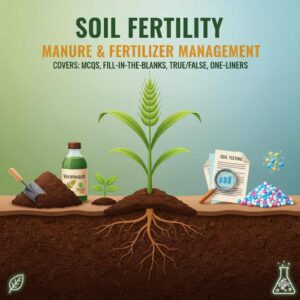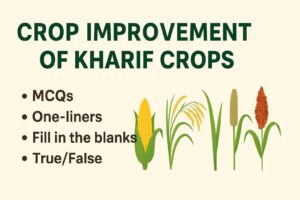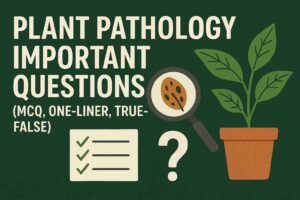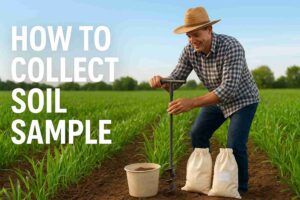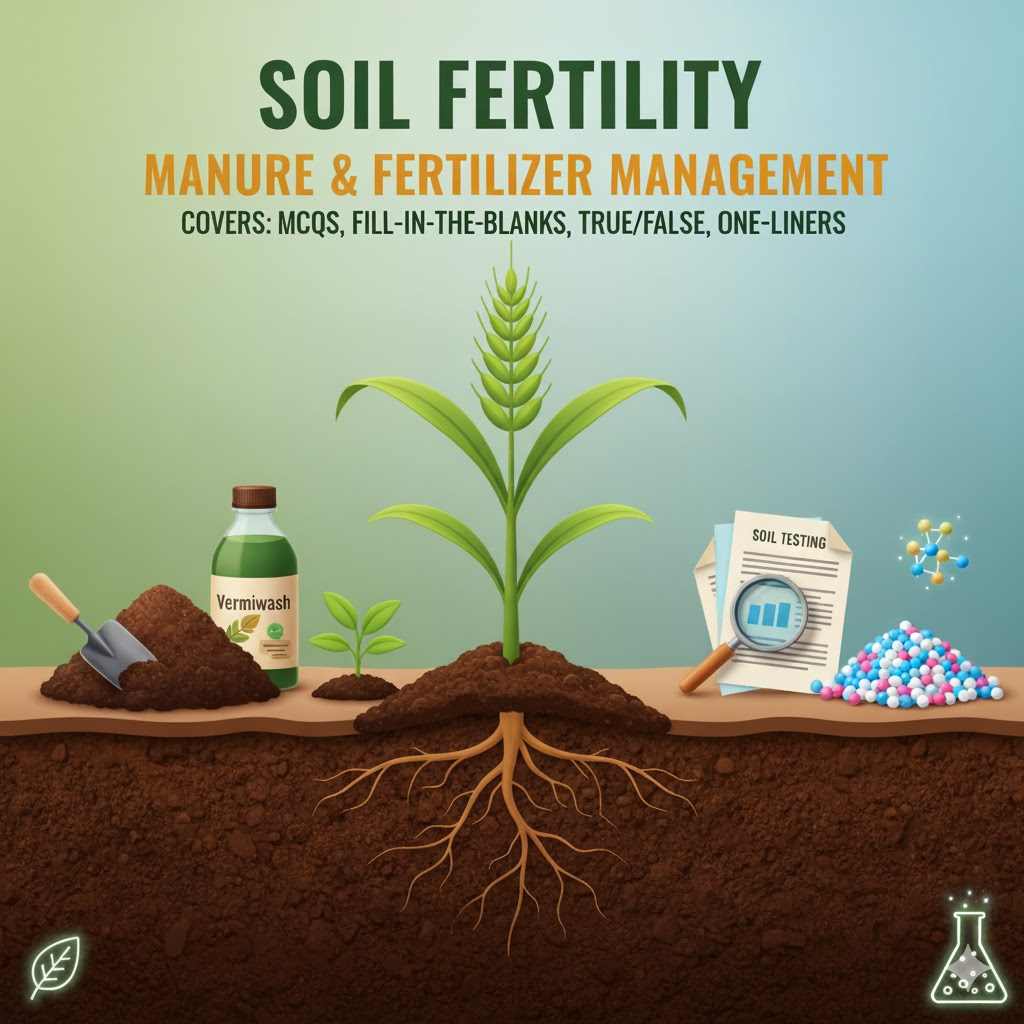
Author–Kumesh choudhari
Table of Contents
Hey Agri-dost! Exam season is around the corner, and we all know that one subject that’s both fascinating and a bit tricky: Manure, Fertilizer, and Soil Fertility Management. It’s a huge subject, right? From the C:N ratio of FYM to the complexities of the Fertilizer Control Order, there’s a lot to cover.
The biggest challenge isn’t just learning the theory but mastering the application, especially when the exam paper is full of MCQs, fill-in-the-blanks, and tricky true/false questions. Ek galat concept, aur seedha negative marking ka dar! These objective questions are designed to test your deep understanding, not just your memory.
But don’t you worry! As an agriculture student myself, I understand the pressure. That’s why I’ve put together this ultimate guide. Consider this your go-to resource for cracking the objective part of your soil fertility paper.
In this post, we are going to cover the most important, conceptually-driven Manure, Fertilizer, and Soil Fertility Management MCQs, one-liners, and other objective questions, topic-by-topic. This isn’t just a random question bank; it’s a curated collection designed to clear your concepts and prepare you for those tricky questions your professor loves to set.
So, grab a cup of chai, get your notebook ready, and let’s dive deep into the world of plant nutrition. Let’s turn this challenging subject into your highest-scoring one! Ready? Let’s begin.
Top 50 BSc Agriculture Manure, Fertilizer, and Soil Fertility Management (MCQs)
Section A: Organic Manures & Integrated Nutrient Management
1. In the Bangalore method of composting, the primary decomposition process is:
a) Aerobic followed by anaerobic
b) Purely aerobic
c) Purely anaerobic
d) Aerobic for a short period, then anaerobic ✅
2. Which of the following has the narrowest C:N ratio, making its nitrogen readily available upon application?
a) Fresh wheat straw
b) Sawdust
c) Well-decomposed FYM
d) Groundnut cake ✅
3. For green manuring, a crop like Sesbania aculeata (Dhaincha) should ideally be incorporated into the soil:
a) At the seedling stage
b) Just before the flowering stage ✅
c) After seed setting
d) When the stems become woody
4. The core principle of Integrated Nutrient Management (INM) is to:
a) Replace chemical fertilizers with organic manures completely
b) Use only bio-fertilizers for crop nutrition
c) Maintain soil fertility and crop productivity through judicious use of organic, inorganic, and biological sources ✅
d) Apply nutrients based on soil color and texture
5. Vermiwash, a byproduct of vermicomposting, is primarily used as a:
a) Soil conditioner to improve structure
b) High-nitrogen solid manure
c) Liquid foliar spray rich in hormones and micronutrients ✅
d) Material to control soil-borne pathogens
6. Azolla is a unique green manure primarily used in rice paddies because it is a:
a) Legume with root nodules
b) Free-floating fern that fixes nitrogen via a symbiotic cyanobacteria (Anabaena) ✅
c) Non-symbiotic nitrogen-fixing bacteria
d) Plant that solubilizes phosphorus
7. Which one is considered a ‘concentrated’ organic manure?
a) Farm Yard Manure (FYM)
b) Town compost
c) Castor cake ✅
d) Sheep manure
8. The main advantage of the Indore method over the Bangalore method of composting is:
a) It requires less labor
b) It produces compost in a shorter time ✅
c) It does not require any turning
d) It conserves more nitrogen
9. ‘Night soil’ refers to:
a) Soil collected at night for analysis
b) A type of compost prepared in pits
c) Human excreta (both solid and liquid) ✅
d) Manure from nocturnal animals
10. Poultry manure is richer in Nitrogen and Phosphorus than FYM primarily because:
a) Birds have a more efficient digestive system
b) Liquid and solid excreta are excreted together, reducing nitrogen loss ✅
c) It is less bulky
d) The feed given to poultry is highly concentrated
Section B: Chemical Fertilizers & Regulations
1. Which of the following fertilizers has the highest equivalent acidity?
a) Urea
b) Ammonium sulphate
c) Anhydrous ammonia ✅
d) Ammonium chloride
2. Diammonium Phosphate (DAP) is a popular complex fertilizer because:
a) It has the highest total nutrient content (N+P) ✅
b) It supplies nitrogen in both ammoniacal and nitrate forms
c) It is highly suitable for acidic soils
d) It has a neutral effect on soil pH
3. Under the Fertilizer Control Order (FCO) of India, ‘bio-fertilizers’ are regulated to ensure:
a) A minimum nutrient content
b) A minimum number of viable microorganisms per gram of carrier ✅
c) A specific color and particle size
d) That they are 100% organic
4. Which phosphatic fertilizer is recommended for application in strongly acidic soils?
a) Single Super Phosphate (SSP)
b) Diammonium Phosphate (DAP)
c) Rock Phosphate ✅
d) Triple Super Phosphate (TSP)
5. Nano-Urea is considered more efficient than conventional prilled urea mainly because:
a) It provides nitrogen more slowly over time
b) Its smaller particle size leads to better absorption and reduced losses ✅
c) It contains more nitrogen per unit weight
d) It can be applied directly to the soil
6. Which fertilizer is also considered a soil amendment for reclaiming alkaline/sodic soils?
a) Muriate of Potash (MOP)
b) Urea
c) Gypsum (CaSO₄·2H₂O) ✅
d) Dolomite (CaMg(CO₃)₂)
7. Ammonium nitrate is often handled with great care because it is:
a) Highly corrosive
b) Extremely hygroscopic and potentially explosive ✅
c) Prone to high leaching losses
d) Very acidic in nature
8. A fertilizer bag is marked with the grade 12-32-16. This indicates it contains:
a) 12% N, 32% P, 16% K
b) 12% N, 32% P₂O₅, 16% K₂O ✅
c) 12% NO₃⁻, 32% P, 16% K
d) 12% N₂, 32% P₂O₅, 16% K₂O
9. Urea is classified as an ‘organic’ nitrogenous fertilizer because:
a) It is derived from natural sources
b) It contains carbon in its chemical structure (CO(NH₂)₂) ✅
c) It has no effect on soil pH
d) It is not harmful to soil microbes
10. Single Super Phosphate (SSP) is a valuable fertilizer, especially for oilseed crops, because besides Phosphorus, it also supplies:
a) Magnesium and Zinc
b) Calcium and Sulphur ✅
c) Potassium and Boron
d) Iron and Manganese
Section C: Plant Nutrition Fundamentals
1. According to Arnon and Stout’s criteria of essentiality, a nutrient is essential if:
a) It is required by the plant in large amounts
b) Its deficiency can be corrected by applying another nutrient
c) The plant cannot complete its life cycle without it ✅
d) It is a component of the chlorophyll molecule
2. Yellowing (chlorosis) of lower, older leaves is a classic deficiency symptom of a mobile nutrient like:
a) Sulphur (S)
b) Nitrogen (N) ✅
c) Boron (B)
d) Calcium (Ca)
3. The movement of ions from soil solution into root cells via carrier proteins against a concentration gradient is called:
a) Mass flow
b) Diffusion
c) Root interception
d) Active transport ✅
4. “Luxury consumption” is a phenomenon where plants absorb a nutrient far in excess of their needs without any increase in yield. This is most commonly associated with:
a) Phosphorus (P)
b) Nitrogen (N)
c) Potassium (K) ✅
d) Zinc (Zn)
5. Which element is a central component of the chlorophyll molecule?
a) Iron (Fe)
b) Manganese (Mn)
c) Magnesium (Mg) ✅
d) Nitrogen (N)
6. The “Law of the Minimum” was proposed by:
a) Arnon and Stout
b) Justus von Liebig ✅
c) S.A. Waksman
d) M.S. Swaminathan
7. Excessive application of phosphorus can induce the deficiency of which micronutrient due to antagonism?
a) Boron (B)
b) Molybdenum (Mo)
c) Zinc (Zn) ✅
d) Chlorine (Cl)
8. Tip hooking of terminal buds and death of growing points are characteristic deficiency symptoms of:
a) Potassium (K)
b) Calcium (Ca) ✅
c) Magnesium (Mg)
d) Sulphur (S)
9. Which nutrient is crucial for the synthesis of certain amino acids (cysteine, methionine) and is a component of vitamins like biotin and thiamine?
a) Nitrogen
b) Phosphorus
c) Boron
d) Sulphur ✅
10. The condition known as ‘Hidden Hunger’ in plants refers to:
a) Severe visible deficiency symptoms
b) A stage where nutrient deficiency reduces yield without showing any clear visual symptoms ✅
c) Toxicity symptoms from over-fertilization
d) A lack of water, not nutrients
Section D: Soil Chemistry of Nutrients
1. In waterlogged rice paddy soils, the dominant available form of nitrogen is:
a) Nitrate (NO₃⁻)
b) Ammoniacal (NH₄⁺) ✅
c) Nitrite (NO₂⁻)
d) Gaseous Nitrogen (N₂)
2. The conversion of ammonium (NH₄⁺) to nitrate (NO₃⁻) by soil bacteria is a two-step process. The bacterium responsible for the second step (nitrite to nitrate) is:
a) Nitrosomonas
b) Rhizobium
c) Nitrobacter ✅
d) Azotobacter
3. In highly acidic soils (pH < 5.5), the availability of phosphorus is drastically reduced due to its fixation by:
a) Calcium and Magnesium
b) Soluble salts
c) Iron and Aluminum oxides ✅
d) High organic matter
4. The temporary assimilation of inorganic soil nitrogen into the organic compounds of microbial tissues is known as:
a) Denitrification
b) Mineralization
c) Nitrification
d) Immobilization ✅
5. Which of the following clay minerals has the highest capacity for fixing potassium (K)?
a) Kaolinite
b) Montmorillonite
c) Illite (or hydrous mica) ✅
d) Allophane
6. Chelates are used in agriculture to increase the availability of:
a) Macronutrients like N, P, K
b) Secondary nutrients like Ca, Mg
c) Micronutrients like Fe, Zn, Mn ✅
d) All nutrients equally
7. Denitrification is the microbial reduction of nitrate to gaseous N (N₂, N₂O) and is most likely to occur under which condition?
a) Well-drained, aerated soils
b) Cold and dry soils
c) Anaerobic (waterlogged) and warm soils ✅
d) Highly acidic soils
8. The process that converts organic nitrogen and phosphorus in soil organic matter back into plant-available inorganic forms is:
a) Chelation
b) Mineralization ✅
c) Volatilization
d) Adsorption
9. The availability of most micronutrients (except Molybdenum) generally:
a) Increases as soil pH increases
b) Decreases as soil pH increases ✅
c) Is not affected by soil pH
d) Is highest at a neutral pH of 7.0
10. Sulphur can be lost from the topsoil through leaching, primarily in its… form:
a) Sulphide (S²⁻)
b) Elemental Sulphur (S)
c) Sulphate (SO₄²⁻) ✅
d) Organic Sulphur
Section E: Soil Fertility Evaluation & Recommendations
1. A soil test report shows a phosphorus level of 8 kg/ha. If the critical level for P in that soil for wheat is 12 kg/ha, it means:
a) The crop will not respond to P fertilizer application
b) The crop is likely to respond positively to P fertilizer application ✅
c) The soil has toxic levels of phosphorus
d) No conclusion can be drawn
2. Plant tissue analysis is generally considered more reliable than soil testing for diagnosing the status of:
a) Soil pH
b) Soil texture
c) Micronutrients ✅
d) Soil organic carbon
3. The Diagnosis and Recommendation Integrated System (DRIS) is an advanced method for interpreting plant analysis results that primarily uses:
a) Absolute nutrient concentrations
b) Ratios of nutrient concentrations ✅
c) Visual deficiency symptoms
d) The color of the plant sap
4. Which of the following practices is most effective for increasing the Nitrogen Use Efficiency (NUE) of urea?
a) Broadcasting the fertilizer on the soil surface
b) Applying the entire dose at the time of sowing
c) Deep placement or incorporation into the soil ✅
d) Applying it during heavy rainfall
5. For a general soil fertility assessment, a composite soil sample is typically collected from a depth of:
a) 0-5 cm
b) 0-15 cm (plow layer) ✅
c) 30-45 cm
d) 50-60 cm
6. A “rapid tissue test” performed in the field measures the concentration of:
a) Total nutrients in the plant
b) Nutrients bound in organic compounds
c) Unassimilated, soluble nutrients in the plant sap ✅
d) Nutrients present in the chlorophyll
7. Olsen’s reagent (0.5 M Sodium Bicarbonate) is the standard extractant used to determine available phosphorus in which type of soils?
a) Strongly acidic soils
b) Neutral to alkaline soils ✅
c) Saline soils
d) Waterlogged soils
8. Cauliflower is often used as an “indicator plant” because it shows very distinct deficiency symptoms for:
a) Potassium (K)
b) Nitrogen (N)
c) Boron (B) and Molybdenum (Mo) ✅
d) Zinc (Zn)
9. The concept of “Targeted Yield Equation” for fertilizer recommendation requires:
a) Only a soil test report
b) Only the crop variety
c) Soil test values, nutrient requirement per quintal of produce, and contribution from soil and fertilizer ✅
d) The farmer’s personal experience
10. Split application of mobile nutrients like Nitrogen is recommended to:
a) Reduce the cost of fertiliser
b) Synchronise nutrient supply with crop demand and minimize losses ✅
c) Increase the soil’s organic matter content
d) Make the application process easier for the farmer
Top 30 BSc Agriculture Manure, Fertilizer, and Soil Fertility Management (Fill in the Blanks)
Part-1
1. The C:N ratio of well-decomposed Farm Yard Manure (FYM) is approximately 20:1.
2. The Indore method of composting is primarily an aerobic process.
3. The nutrient content of a fertilizer is legally guaranteed under the Fertilizer Control Order (FCO).
4. The criteria of essentiality for plant nutrients were given by Arnon and Stout.
5. The conversion of ammonium to nitrate in the soil is called nitrification.
6. For diagnosing nutrient status, a soil test measures the available form of nutrients.
7. A non-edible oil cake rich in nitrogen and also having nematicidal properties is neem cake.
8. The fertilizer grade 18-46-0 corresponds to Diammonium Phosphate (DAP).
9. Deficiency of immobile nutrients like calcium and boron first appears on the upper or younger leaves.
10. The process of nutrient movement to the root surface with the flow of water is known as mass flow.
11. In highly acidic soils, phosphorus gets fixed by iron and aluminum oxides.
12. The reagent used for determining available phosphorus in neutral to alkaline soils is Olsen’s reagent (0.5 M NaHCO₃).
13. The process of incorporating a green manure crop into the soil is known as trampling or ploughing-in.
14. Anhydrous ammonia has the highest nitrogen content (82%) and also the highest equivalent acidity.
15. The element that acts as a catalyst for chlorophyll formation but is not a constituent of it is Iron (Fe).
Part-2
16. The central atom of the chlorophyll molecule is Magnesium (Mg).
17. The loss of nitrogen from the soil in gaseous form under anaerobic conditions is called denitrification.
18. Rapid plant tissue tests measure the concentration of unassimilated/soluble nutrients in the plant sap.
19. The two microorganisms involved in nitrification are Nitrosomonas and Nitrobacter.
20. Single Super Phosphate (SSP) contains 16% P₂O₅, 12% Sulphur, and 19% Calcium.
21. The phenomenon of absorbing a nutrient far in excess of need without increasing yield is called luxury consumption.
22. An example of a complex fertilizer is Diammonium Phosphate (DAP) or NPK mixtures.
23. The temporary conversion of inorganic soil nitrogen into microbial biomass is known as immobilization.
24. A plant that shows distinct and specific deficiency symptoms for a particular nutrient is called an indicator plant.
25. Muriate of Potash (MOP) is chemically known as Potassium Chloride (KCl).
26. The term ‘Hidden Hunger‘ refers to a nutrient deficiency that reduces crop yield without showing visible symptoms.
27. The ability of certain clay minerals, like Illite, to trap potassium ions is known as K-fixation.
28. The formula used for fertilizer recommendation that considers nutrient contribution from soil, fertilizer, and manure is the Targeted Yield Equation.
29. Gypsum (CaSO₄·2H₂O) is used as a soil amendment to reclaim alkaline/sodic soils.
30. The ratio of nutrient uptake by the crop to the quantity of nutrient applied is known as Nutrient Use Efficiency (NUE).
Top 30 BSc Agriculture Manure, Fertilizer, and Soil Fertility Management (True/False Questions )
Part-1
The final product of the Bangalore method of composting is a more decomposed and humus-rich material than the Indore method.
Answer: True
Green manuring with a leguminous crop decreases the organic matter content of the soil.
Answer: False
Vermiwash is primarily used to improve soil structure and water holding capacity.
Answer: False (It’s a liquid foliar spray for nutrients and growth hormones.)
Urea, with the chemical formula CO(NH2)2, is considered an organic fertilizer.
Answer: True
The fertilizer grade on a bag, such as 12-32-16, represents the percentage of elemental N, P, and K.
Answer: False (It represents % N, % P2O5, and % K2O.)
Sulphate of Potash (SOP) is preferred over Muriate of Potash (MOP) for chloride-sensitive crops like tobacco and potato.
Answer: True
The “Law of the Minimum” was proposed by Arnon and Stout.
Answer: False (It was proposed by Justus von Liebig.)
Deficiency symptoms of an immobile nutrient like Sulphur will first appear on the lower, older leaves.
Answer: False (They appear on upper, younger leaves.)
Active transport is the movement of nutrients into the root cells against a concentration gradient, requiring energy.
Answer: True
The central element of the chlorophyll molecule is Iron (Fe).
Answer: False (It is Magnesium, Mg.)
In waterlogged soil conditions, the process of denitrification is common, leading to the loss of nitrogen as gas.
Answer: True
Phosphorus availability is at its maximum in highly acidic soils (pH < 5.0).
Answer: False (It gets fixed by Iron and Aluminum.)
The conversion of ammonium to nitrite is carried out by Nitrobacter bacteria.
Answer: False (It’s done by Nitrosomonas.)
Chelation is a process that reduces the availability of micronutrients in the soil.
Answer: False (It increases their availability.)
Soil testing measures the total amount of a nutrient present in the soil.
Answer: False (It measures the plant-available fraction.)
Part-2
The “critical nutrient level” is the level below which a crop is likely to respond to the application of that nutrient.
Answer: True
Rapid plant tissue tests are used to determine the total nutrient content in a plant.
Answer: False (They measure soluble, unassimilated nutrients in the sap.)
Broadcasting urea on a high pH soil surface on a hot day can lead to significant nitrogen loss through volatilization.
Answer: True
Integrated Nutrient Management (INM) advocates for the complete replacement of chemical fertilizers with organic manures.
Answer: False (It advocates for the judicious and combined use of all sources.)
Rock Phosphate is a fast-acting, water-soluble phosphatic fertilizer.
Answer: False (It’s a slow-acting, acid-soluble fertilizer.)
A plant can complete its life cycle even in the complete absence of an essential nutrient.
Answer: False
“Hidden Hunger” refers to a condition where a plant shows severe, visible deficiency symptoms.
Answer: False (It’s a yield reduction without visible symptoms.)
The availability of Molybdenum increases as the soil becomes more acidic.
Answer: False (It is the opposite; its availability increases with increasing pH.)
A composite soil sample for testing should be made by mixing soils from different depths, like 0-15 cm and 30-45 cm.
Answer: False (A composite sample should be from a uniform depth, typically 0-15 cm.)
Applying the entire dose of a highly mobile nutrient like Nitrogen at the time of sowing is the most efficient practice.
Answer: False (Split application is more efficient.)
Oil cakes are classified as bulky organic manures.
Answer: False (They are concentrated organic manures.)
The nutrient content in Farm Yard Manure (FYM) is highly variable.
Answer: True
Nano fertilizers are applied in larger quantities compared to conventional fertilizers to be effective.
Answer: False (They are applied in much smaller quantities due to high efficiency.)
Luxury consumption is a phenomenon most commonly associated with Nitrogen.
Answer: False (It is most commonly associated with Potassium.)
The primary purpose of the Fertilizer Control Order (FCO) is to ensure the quality and correct labeling of fertilizers sold in the market.
Answer: True
Top 30 BSc Agriculture Manure, Fertilizer, and Soil Fertility Management (One‑liners Questions)
Q1: What is the primary objective of Integrated Nutrient Management (INM)?
➡️ 🟩 To maintain long-term soil fertility and crop productivity by combining organic, inorganic, and biological nutrient sources
Q2: Which green manure crop is a floating fern used in rice paddies?
➡️ 🟦 Azolla pinnata, which fixes nitrogen through a symbiotic relationship with Anabaena
Q3: Name the process responsible for the loss of nitrogen as ammonia gas from surface-applied urea.
➡️ 🟩 Volatilization
Q4: What is the chemical name for Muriate of Potash (MOP)?
➡️ 🟦 Potassium Chloride (KCl)
Q5: Which fertilizer is unique because it provides Nitrogen, Phosphorus, and Sulphur?
➡️ 🟩 Ammonium Phosphate Sulphate
Q6: Who is credited with proposing the “Law of the Minimum”?
➡️ 🟦 Justus von Liebig
Q7: Which essential nutrient is a key component of the middle lamella in plant cell walls?
➡️ 🟩 Calcium (Ca)
Q8: What is the term for the death of plant tissue, often appearing as brown or black spots?
➡️ 🟦 Necrosis
Q9: Name the free-living (non-symbiotic) bacteria that fixes atmospheric nitrogen in the soil.
➡️ 🟩 Azotobacter or Clostridium
Q10: In which pH range is the availability of soil phosphorus generally at its maximum?
➡️ 🟦 6.5 to 7.5 (Slightly acidic to neutral)
Q11: What is the standard extractant used to determine available Potassium in soil testing labs?
➡️ 🟩 Neutral 1N Ammonium Acetate
Q12: What does the acronym DRIS stand for in the context of plant analysis?
➡️ 🟦 Diagnosis and Recommendation Integrated System
Q13: What is the C:N ratio of sawdust, which leads to temporary nitrogen immobilization if not composted?
➡️ 🟩 Very wide, approximately 400:1
Q14: Name the concentrated organic manure that also has nematicidal properties.
➡️ 🟦 Neem Cake
Q15: What is the nutrient content (N−P₂O₅−K₂O) in Single Super Phosphate (SSP)?
➡️ 🟩 0-16-0 (It also contains Sulphur and Calcium)
Q16: Which nutrient is known for its role in opening and closing of stomata?
➡️ 🟦 Potassium (K)
Q17: The ‘whiptail’ symptom in cauliflower is caused by the deficiency of which micronutrient?
➡️ 🟩 Molybdenum (Mo)
Q18: What is the term for the process where soil microbes convert organic nitrogen into plant-available ammonium?
➡️ 🟦 Mineralization
Q19: Which type of clay mineral is known for its high capacity to fix potassium?
➡️ 🟩 Illite (or hydrous mica)
Q20: Why is plant tissue analysis sometimes preferred over soil testing for micronutrients?
➡️ 🟦 Because it gives a more accurate picture of the actual nutrient uptake by the plant
Q21: Name a fertilizer that has a high risk of explosion and is regulated for this reason.
➡️ 🟩 Ammonium Nitrate
Q22: What is the primary difference between a ‘straight’ fertilizer and a ‘complex’ fertilizer?
➡️ 🟦 A straight fertilizer supplies one primary nutrient, while a complex fertilizer supplies two or more
Q23: Which beneficial element is known to improve resistance to lodging and diseases in crops like rice and sugarcane?
➡️ 🟩 Silicon (Si)
Q24: What is ‘luxury consumption’ in plant nutrition?
➡️ 🟦 When a plant absorbs a nutrient (especially Potassium) far beyond its needs without any increase in yield
Q25: The “Purdue Leaf Color Chart” is used for rapid, in-field assessment of which nutrient’s status in crops?
➡️ 🟩 Nitrogen (N)
Q26: What is the chemical used to reclaim sodic (alkaline) soils?
➡️ 🟦 Gypsum (CaSO₄·2H₂O)
Q27: In what form is Boron primarily absorbed by plants from the soil solution?
➡️ 🟩 As Boric acid (H₃BO₃)
Q28: What is the name of the method where fertilizer is placed in a band to the side and slightly below the seed?
➡️ 🟦 Band Placement
Q29: Which byproduct of vermicomposting is used as a liquid foliar spray?
➡️ 🟩 Vermiwash
Q30: What is the full form of NUE, a key metric for fertilizer efficiency?
➡️ 🟦 Nutrient Use Efficiency
Difference between soil fertility and productivity

Get more MCQs and PYQs
Download BSc agriculture All Subject Notes PDFs
BSc Ag. Semseter Name | English Notes PDFs |
1st semester | |
2nd semester | |
3rd semester | |
4th semester | |
5th semester | |
6th semester |
Also Download Best Agriculture Books
Book Title | Author/Publisher | Availability |
A Competitive Book of Agriculture | Nem Raj Sunda | |
Fundamentals of Agriculture (Vol. 1 & 2) | Arun Katyan | |
Objective Agriculture | S.R. Kantwa | |
Principles of Agronomy | T. Yellamanda Reddy & G.H. Sankara Reddi | |
Introductory Soil Science | D.K. Das | |
Plant Breeding: Principles and Methods | B.D. Singh | |
Textbook of Plant Pathology | P.D. Sharma | |
A Textbook of Entomology | H.S. Bhamrah | |
General Knowledge | Lucent's Publication | |
Animal husbandry | adda |
Read Latest post
100+ Manure, Fertilizer, and Soil Fertility Management MCQ with important one-liners, true/false & fill-in-the-blanks
Author–Kumesh choudhari Table of Contents Hey Agri-dost! Exam season is...
Read MoreBSc Agriculture Crop Improvement of Kharif Crops MCQ, one-liner, true/false & fill in the blanks questions for exams
Author–Kumesh choudhari For every agriculture student, understanding the BSc Agriculture...
Read MoreBSc Agriculture Plant Pathology MCQ, one-liner, true/false & fill in the blanks questions for exams
Author–Kumesh choudhari Preparing for BSc Agriculture Plant Pathology MCQ-based exams is never...
Read Morehow to collect soil sample for soil testing
Introduction of how to collect a soil sample for...
Read More
